This week we investigate why the UK is investing in space weather forecasts. Plus how could changes in the Sun's activity affect us here on Earth? In the news, conservationists supporting the sale of a hunting licence for the endangered Black Rhino, gene therapy success for treating blindness-causing diseases, and do humans use anger strategically?
In this episode

01:16 - Human strategic use of anger
Human strategic use of anger
People intentionally anger others to gain a competitive advantage in certain sitations, new research has shown.
When the celebrated French footballer Zidane was famously sent off for headbutting a member of the other team in the 2006 World Cup, most likely costing France the match in the process, he protested that his Italian opponent had insulted him. But, by being provocative, was Marco Materazzi, the Italian player, craftily counting on Zidane reacting the way he did?
Citing this case, Uri Gneezy, from UCSD, Alex Imas, from the University of Amsterdam, have shown that humans do indeed appear to resort to strategic anger to advantage themselves in certain situations.
In their paper, published in PNAS, the duo recruited volunteers to participate in two competitive tests, one a show of strength, the other a cognitive challenge.
First, the participants had to squeeze a handle as hard as they could. The winner was judged to be the person who applied the largest force registered by the machine.
After the first round of measurements, one of the participants was told that he could choose how much time, up to a maximum of 20 minutes, the other participant had to stay behind after the tests to complete all of the study paperwork for both of them. A cost incentive was applied so that the "decision maker" received a larger cash bonus the longer the other person was kept waiting.
The two participants then compared grip strengths again. This time, the participants who had been told they would be kept waiting performed significantly better, indicating that anger under these circumstances gave them an advantage.
In the second task, a different group of participants took part in a fantasy duel. They were placed a certain number of steps away from each other and took turns either to advance by one step, or shoot. At each stage they were told the probability that they would hit their opponent if they decided to shoot from that location.
The likelihood of a hit increased as the distance between the participants closed, but not by a fixed amount. This meant that the best strategy to win was to advance 15 steps before electing to shoot.
Again, in this test, one of the two participants was "angered" in the same way as the volunteers in the first task, by telling them the other participant had chosen for them to remain behind afterwards.
But unlike in the first task, when anger was advantageous, this time the angry participants were significantly disadvantaged by their ire, making worse choices and frequently electing to shoot too soon so, on average, they lost the game.
In either task, though, given the chance to "cool off" for 10 minutes after being angered removed the bias, confirming that acute anger was the cause.
So were the participants subconsciously aware of the impact that anger might have on their oppoents in these tasks? The results suggest that they were and that they were using anger strategically: in the strength task, only 45% of the participants assigned the full 20 minute hold-up to their opponent, compared with 63% of participants in the duelling task.
"These results," say Gneezy and Imas, "suggest that individuals anticipated the behavioural effects of anger and used the strategically - they were more willing to anger their opponents when it had a detrimental effect on their performance."
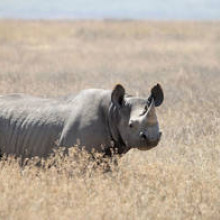
05:49 - Hunting the Black Rhino
Hunting the Black Rhino
with Mike Knight, Chairman IUCN SSC African Rhino Specialist Group
Last weekend the American hunting group, the Dallas Safari Club raised $350,000 by selling a hunting license to shoot one of only 5,000 black rhino's remaining in the wild.
You might think that conservationists and animal rights groups would be up in arms about this, and unsurprisingly some are. But, the International Union for Conservation of Nature are supporting the sale. Dominic Ford was joined from South Africa by Mike Knight, the chair of the IUCN rhino specialist group....
Mike - Obviously we're facing the threat at the moment from escalating poaching that's been driven by the demand for horn in the Far East. Last year, we lost 1,004 animals. Most of which in South Africa, but I think obviously, the focus of this discussion would be looking at Namibia who have lost only two animals.
Dominic - So, given that there are only 5,000 of these rhinos remaining in the wild, why are you supporting the sale of a hunting license to actually kill one of them?
Mike - Well, the whole thing around rhinos and particularly rhinos, these hunting applications were focused primarily on males which we've actually coined as surplus males and it's primarily the old geriatric males. These males are often involved in fighting. In many cases, females are killed, and in Namibia for instance, up to 30% of animals that are lost in Namibia are a result of fighting. In many cases, that's females.
The last thing you ever want to lose in a population that is of that size is to lose the breeding stock and to lose the females. So, what we have to do in a situation like this is try and make sure we do the best for males. Putting the males onto other land or alternative land has huge cost implications. It's also taking away the opportunities for breeding populations. So really, the best way to turn this around is to actually use these surplus males and remember, there's only 5 animals given in South Africa and Namibia as part of the hunting quota and that money goes directly back into conservation. So yes, they are in some ways sacrificial, but to the same extent, they have great financial returns towards rhino conservation. The case in Namibia, that money was ploughed 100% back into conservation.
Dominic - How does that surplus males come about? Is that behavioural?
Mike - It's behavioural. It's black rhino. Black rhinos are notably aggressive. At the moment, in many of the populations, they are distorted towards males and populations that have the larger proportion of breeding males don't perform as well as those where the proportion of males are less. So, what we try and do in many situations is skew the sex ratio in favour of females to get them breeding as fast as we possibly can.
And then the question is, what do you do with these surplus males? In the case in Namibia, the males that they're actually talking about are ones that have often been kicked out of Etosha National Park. In many cases, they've put these animals back into the park, but in 90% of the cases, those animals have either been killed or they've killed other animals. So, the best thing is actually is right. Let's try and get a conservation benefit from this and that conversation benefit is in the form of rands or in dollars which goes directly into conservation.
Dominic - What sort of reaction have you had from the international community to this decision to sell this license?
Mike - I think, a lot of it comes around possibly from ignorance, not understanding the context in which we're talking about. As you know, Southern Africa follows a sustainable use approach to the wildlife and you can see that in the amount of wildlife and the amount of land set for conservation. So, in the Southern African context, we've had an outcry in many ways to say, "Yes, the animal could've been auctioned for a million, but went for 350,000. What happened to the other 650,000 that should've gone directly into conservation?" That is money lost to rhino conservation.
Dominic - Very quickly, what will you spend that money on?
Mike - It goes directly into anti-poaching. Into training, into monitoring and improving the situation for rhino conservation.
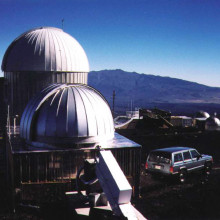
09:59 - Keeling Curve Crowdfunding
Keeling Curve Crowdfunding
Crowd funding programmes like Kick-starter have been used to raise money for music 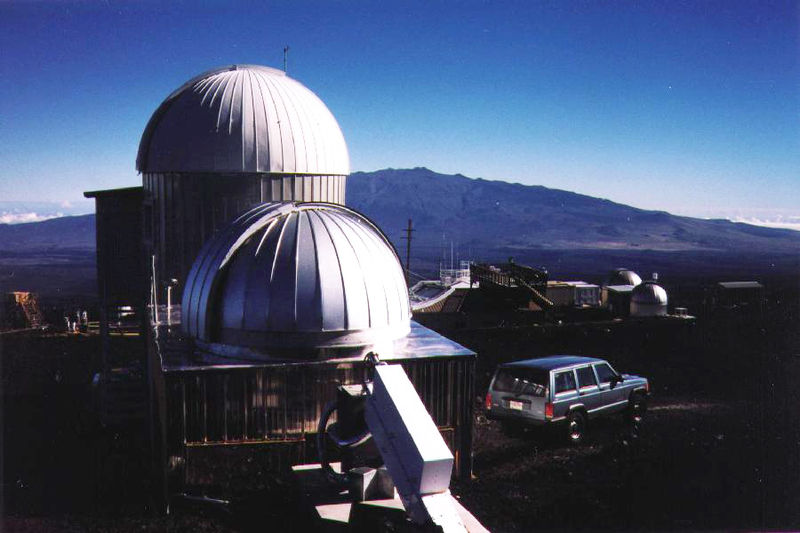 projects and Hollywood films, but now it could even be used to raise funding for long running scientific projects.
projects and Hollywood films, but now it could even be used to raise funding for long running scientific projects.
The so-called Keeling Curve is the world's longest unbroken record of how much carbon dioxide is in the atmosphere, but after funding cuts it's now asking the public to chip in to keep the data going.
To find out more about this archive and the gas it measures, here's your Quick Fire Science with Kate Lamble and Dave Ansell.
Carbon dioxide, or CO2, is given off whenever any carbon-containing material is burnt, whether that's a candle or a piece of coal dug up from the ground.
The colourless and odourless gas was first identified by Flemish alchemist Jan Baptista van Helmont in 1648, who described it as a gas given off by burning charcoal.
Plants absorb 420 billion tonnes of CO2 every year. This is in almost perfect balance with the amount of the gas produced by living things during their respiration.
However, since the industrial revolution humans have been burning fossil fuels which had been buried for millions of years, this now produces around an extra 33 billion tonnes of CO2 every year.
Although this is a far smaller amount than naturally produced CO2, if it isn't absorbed it will build up in the atmosphere
In 1859 John Tyndell discovered that CO2 insulates the earth keeping it warm.
This discovery caused some concern, Alexander Graham Bell wrote as far back as 1917 "[The unchecked burning of fossil fuels] would have a sort of greenhouse effect", and "The net result is the greenhouse becomes a sort of hot-house.
But the potential of the effect was not appreciated until the 1960s, when planetary scientists studying Venus realised that the very thick atmosphere of CO2 on that planet had caused the surface temperatures to rise to over 450 celcius.
CO2 concentrations have been measured continuously at Mauna Luo in Hawaii since 1958.
Over the past 56 years, CO2 levels have risen by nearly a third, from 315 parts per million to reaching over 400 parts per million for the first time in recorded history in May 2013.
Scientists estimate that the last time the Earth previously reached these levels was three million years ago in the Pliocene era when average global temperatures and sea levels were higher than they are today.
Sadly if the money cannot be raised and monitoring of the Keeling Curve is halted for even a brief time, it will be very difficult to ensure that future measurements are properly calibrated to match the historical record.
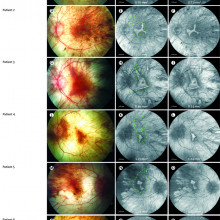
13:22 - Treating blindness with gene therapy
Treating blindness with gene therapy
with Robert MacLaren, University of Oxford
Blindness-causing diseases of the eye have for a long time been regarded as irreversible. 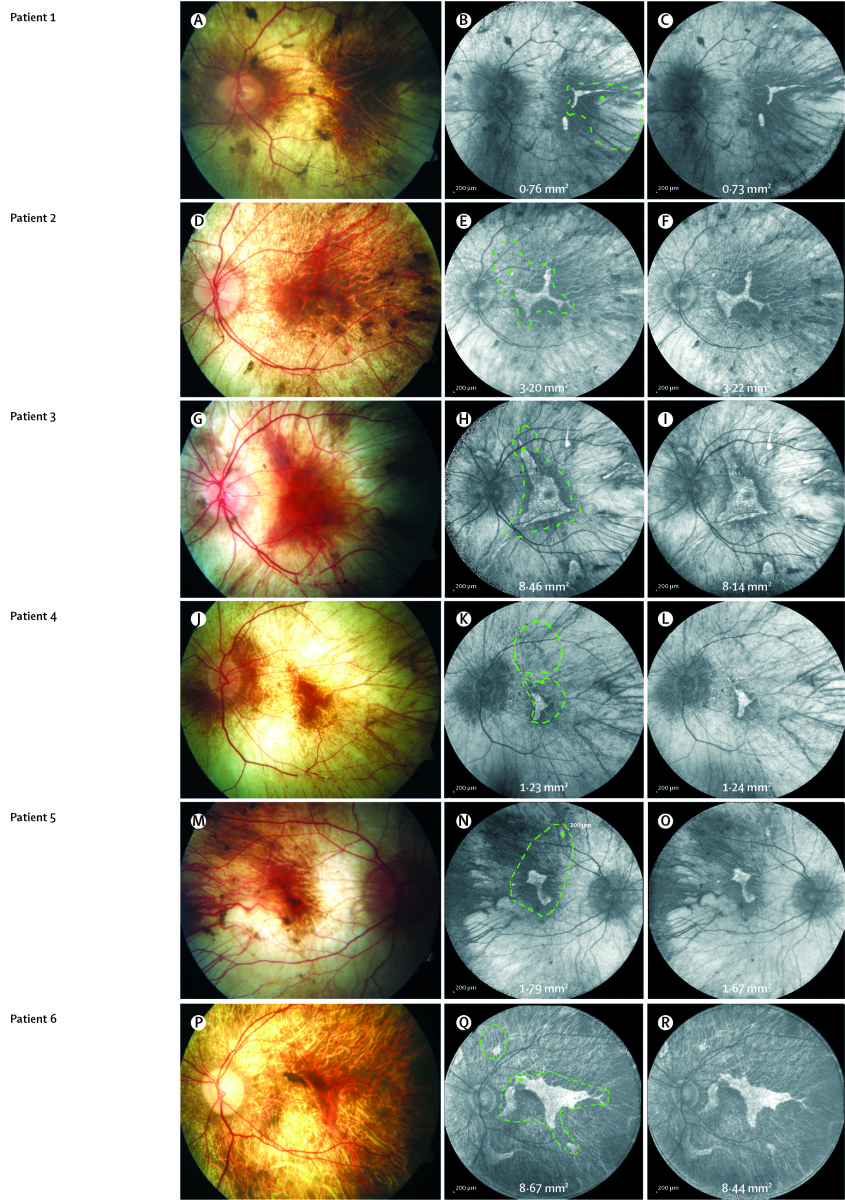 But now scientists have begun to explore whether gene therapy can slow down or reverse the damage.
But now scientists have begun to explore whether gene therapy can slow down or reverse the damage.
Robert Maclaren is heading up one of these studies at the University of Oxford and joined Chris Smith after publishing the first clinical findings this week.
Chris - So, what's the disorder that you've been looking at specifically?
Robert - Well Chris, we're looking at a retinal degeneration which is basically a degeneration of the lining of the back of the eye, the light sensitive sort of film at the back of the eye. The particular disease is caused by a missing gene on the X chromosome. So, it affects males and it's called choroideremia which is an original description given to it, well over 100 years ago.
Chris - People who have this, what happens to them? How would they know they've got the condition?
Robert - Well, quite often, we diagnose it as a new genetic mutation, but sometimes there's a family history. So, a mother might be aware that her son is going to get it. The initial signs would be things like difficulty with night vision, that would occur perhaps in childhood and then gradually, around about the age of 10, 11, 12, the visual field, the peripheral vision becomes constricted. They develop what we sometimes refer to as tunnel vision. So, they can see a little bit in the middle, but all around the outside is all dark. This tunnel vision gets progressively worse. And then sadly, by the time they get to 40s or 50s, they then become completely blind.
Chris - How does the intervention, your gene therapy approach that you're cooking up work?
Robert - Well, the patients have this retinal degeneration because they're missing the choroideremia gene, or the CHM gene for short. This gene is normally present in the light sensing cells and the lining of the back of the retina, the back of the eye. So, the principle of gene therapy is a relatively new concept in medicine. It's actually to try and correct the disease at the genetic level. In the case of choroideremia, what we do is we make a virus that carries DNA, because viruses do carry DNA or RNA, that's the property of virus. Only, rather than carrying the viral gene, the virus contains the choroideremia gene which we've artificially put into it. But nevertheless, the virus on the outside is the same. It retains its same abilities to bind to and infect the retinal cells. It gets into the cells. The virus then releases its payload, thinking it's its own DNA for replication. But in fact, it is the choroideremia gene that goes into those cells. Although we've taken out most of the viral genome, little bits at the very end which stabilise the DNA and allow it to sit in the cell dormantly for years and years, and years, all that is still there. So, as far as we're aware, so far, we are actually looking at in principle, a treatment which should have a permanent and lasting effect.
Chris - Do you administer this virus into the retina? Do you?
Robert - Yes. The patients have to undergo an operation which involves - first of all removing the jelly at the back of the eye and then injecting under the retina, a concentrated solution of virus. Of course, that's a rather tricky bit to do because it's a very delicate process. One of the concerns in our study at the beginning, we realised that gene therapy is really best applied before the onset of vision loss before the cells die. So, we had to really get the virus into the retina in patients before they'd lost their central vision. We did that on 4 patients and fortunately their vision did recover. In fact, what was remarkable was that actually, we could then see the further improvements from before they'd had the operation once the virus was working. So, it is a combination really of biological technology of the virus, but also, trying to develop the technique of surgery better.
Chris - How do you know that it's the virus improving the outcome for these patients and not just the operation or some aspect of having something injected into the eye because I presume, you didn't do the experiment where you just injected water or something into the eye without any virus, just to see what the injection itself does?
Robert - No and of course, that's a very good point. It's very difficult sometimes when doing clinical trials to have a true - what we call, sham injection. But the eye is quite useful because of course, we've got the other eye to look at as well. Also, we know a lot about the natural history of the disease. So when we initially notice the quite significant improvements in vision in these patients, with their permission, particularly the two who had the largest change, we contacted their home opticians to get their historical vision records over many, many years before the trial, and also, an up-to-date vision, just in case there might be something different about our trial system. That verified our findings in the fact that the vision had improved. This is a disease in which the vision gets progressively worse. It's very difficult to understand how it could improve by several lines without something going on and indeed, the effects we've seen in the first patient who gained more than three lines of the standard Snellen chart, the big chart you see at the opticians. He couldn't even see the top letter before the surgery. He can now quite confidently read the top two lines and that's being sustained now for 2 years. So, it's a very good question, I often get asked this and I say, well you know, if it isn't the virus that's doing this, it must be something else. It's still quite amazing. If it is a sham injection or something similar after 2 years, then obviously, it would be difficult to explain through any other reason than the missing gene is now doing its stuff. Of course, the patients do notice improvements in the quality of the visions. That's certainly the case.
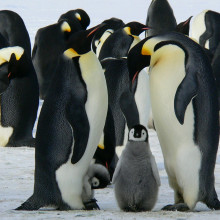
19:06 - Emperor penguins adapt to global warming
Emperor penguins adapt to global warming
Rising temperatures in the Antarctic have led to the largest and heaviest species of penguin - the Emperor penguin - being classified as 'near threatened'.
However, recent satellite images obtained by an international collaboration of conservation groups - led by Peter Fretwell at the British Antarctic Survey - suggest that the Emperor penguin may be much more adaptable to a changing climate than was previously thought.
Emperor penguins rely on the formation of ice floes around the Antarctic coastline in order to breed. These ice sheets provide easy access to the sea, so that the giant birds are able to find fish to eat while raising their young on dry land.
However, rising temperatures mean that the extent of the ice floes which form each winter is shrinking, giving the penguins less room to breed. Unusually warm spells during the winters of 2011 and 2012 threatened to put the penguins under exceptional pressure, as the ice floes hardly formed at all.
But this also gave researchers their first opportunity to see how the penguins would behave when their usual breeding grounds were not available - with many suspecting that the penguins would simply not breed at all in those years.
Satellite images taken during those years, however, have been found to show emperor penguin breeding colonies perched on top of some of the continent's fresh-water ice shelves, often surrounded by thirty-metre-high cliff faces.
Emperor penguins are agile swimmers, but are usually thought of as quite clumsy animals on dry land, and so their ability to scale such ascents came as quite a surprise. But detailed examination of the satellites imaged showed that the penguins had worked out a long and winding path they could tread to reach the top of the shelf.
This adaptability gives hope that the emperor penguins may not be quite so vulnerable to population collapse as previously thought, should their prefered breeding grounds disappear in coming years.
The work is written up in online journal PLOS ONE.
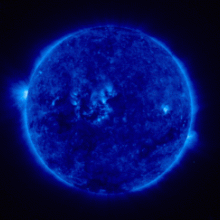
23:23 - Why invest in monitoring the Sun?
Why invest in monitoring the Sun?
with David Willetts, UK Science Minister, Lucie Green, University College London
Just before Christmas, the UK's national weather-forecasting service, the Met Office, 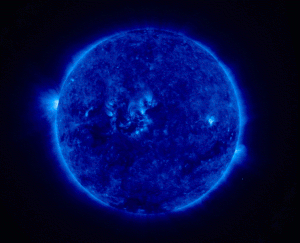 announced that it would begin monitoring the Sun's activity, to advise space agencies and power distribution companies about the hazards that its radiation might pose.
announced that it would begin monitoring the Sun's activity, to advise space agencies and power distribution companies about the hazards that its radiation might pose.
To find out why the UK is investing in this technology, Chris Smith was joined by David Willetts, Minister of State for Universities and Science, and also by Lucie Green from the Mullard Space Science Laboratory of University College London.
Chris - David, first of all, why are you doing this and why are you doing it now?
David - We're doing it because when we look at the kind of strategic threat to the functioning of our national infrastructure, we've got space weather now quite high up on the list as something which is potentially disruptive. So, it would be a great advantage if we were better able to forecast it. Secondly of course, this is just another great example of British science. We have experts who are very good at monitoring solar activity. We are backing projects like solar orbiter, aimed at understanding the activities of the sun better and given that we've got scientists working on this, it's right that we should then harness their researches for better space weather forecasting.
Chris - How big is that hazard?
David - Well, we reckon that as you know, space weather solar activity seems to come in cycles of 11 or 12 years. The experts talk about the Carrington event back in 1859. It was the first great measurement of this activity incidentally from Kew, near where I am in London at the moment, and it does look as if when you have these peaks of solar activity, it can be disruptive in several ways. It can disrupt electricity supplies. It can disrupt the grid. Indeed, two of the most significant power outages in the western world in Quebec in 1989 and in Sweden in 2003 were linked to high levels of solar activity. So, that's an issue and it's why it's important for our electricity grid and infrastructure. And then secondly, satellites. Of course, we're increasingly dependent on satellites. When I talked to the satellite operators, they don't say that necessarily, you'd suddenly have your satellites knocked out. You might want to shut them down for a time and even shutting down a satellite before you - and then having to turn it back on - could interrupt services that we are all used to, delivered via satellites. So, there are reasons why having better information that one of these peaks of solar activity is coming would be of great benefit for us.
Chris - Lucie, can you tell us a bit about what causes the sorts of peaks that David's referring to?
Lucie - So, the peaks in solar activity. In terms of the activity that the sun produces, you've got 4 different types. You've got solar wind which can blow very, very strong, be very gusty and have a strong impact on the Earth's magnetic field and then with a knock-on consequences as David has already been saying about. You have solar flares which are bursts of intense radiation that come towards the Earth, coronal mass ejections which are these eruptions of plasma and magnetic field and also, energetic particle events. All of these four kinds of activity, vary over roughly an 11-year cycle which we call the solar activity cycle. They ebb and flow with that. At the moment, we are at solar maximum.
Chris - But David, the cynic in me is saying, we're still here. There are 7 billion people on Earth. The Earth hasn't melted down yet, but there must've been many, many of these such events in the past. Why do we need this now?
David - Yes. It is a well-established pattern as Lucie is describing. I think what we have to recognize is that first of all, we've got ever greater and more sophisticated electricity distribution systems. And secondly, we are more dependent on satellites than ever before. Third, which I should've added to the list, there are some issues about aircraft, air travel near the poles, how much exposure to radiation there is particularly for pilots and crew who are regularly flying. So, there are several reasons why a modern high tech world is more vulnerable. I think that given that we have this understanding of the science what we're doing, is investing now in the capability. Out of the science budget we've put in about 2 million pounds for the IT infrastructure to really harness the data and we're putting in another 4.5 million pounds or so to deliver operational services. We'll be working very closely with the Americans and I think it's both a great way of ensuring better advanced notice for our infrastructure. It is also pushing forward the frontiers of science and linking science to actual operational requirements like space weather forecasting. I think that's what many scientists like to see us doing, using their increased understanding of things like solar activity and putting it to practical use.
Chris - Looking at it another way though, 4.5 million pounds, that's what a thousand hip replacements, you could probably do a couple of thousand cataract operations and give people their sight back in old age for that same money. There are already people doing space weather forecasting in America. Couldn't we borrow their space weather forecast and make more old people mobile?
David - Well, the science budget is modest compared with the health budget. I think the guaranteed 4.6 billion pounds a year we put in to science is absolutely the right thing to be doing. We should be incredibly proud of the quality of our science. Within that, I think that space science and understanding solar activity is an area where Britain has high quality science. And then in turn - although of course yes, the Americans have got some of these data sets, Britain brings something to the party. We're not simply people who should be sitting around endlessly saying "well we can get it off the Americans". We're very good at writing software. We're very good at solar science. We are genuine partners in this project and like in so many other areas of science activity, if we're bloody good at it and if we've got these capabilities, it's right to use them. We don't need to simply be dependent on other people.
Chris - Fair enough, but I put it to you, I cannot download Downtown Abbey on my computer 6 miles outside of Cambridge, despite the fact that some of those companies that you've sited as making Britain foremost in the world are sighted not far from where I live because my internet connection is so appalling. Should we not be pushing more money into getting our population better connected because regardless of space weather, if there's a big coronal mass ejection, I'm not going to notice because my technology is in the dark ages already.
David - I can sense you have a strong personal grievance there and I would not dispute it. You're absolutely entitled to be frustrated about that and actually, in a separate bit of the government, we are absolutely trying to particularly tackle some of these not spots and get people properly onto fast broadband connections. In fact, I think we're on track for getting further to that by 2015 than most other advanced western countries. But the decision was not - I have to say - the decision that came across my desk was not, "should we put more money into improving broadband services within 6 miles of Cambridge or into space weather forecast." That's not quite how government functions. What we actually had an issue with, what's the best way of using the science budget and the budget that I put into the Met Office. Given that the space weather is actually now on our top 4 or 5 list of national infrastructure problems and risks, it would be a disaster if in a year or two - imagine that we did have power outages. Even dare I suggest, imagine we have power outages in Cambridgeshire and we hadn't had the advanced notice. Now, this is where I'm not an electricity engineer, but my understanding is, if they get some advanced notice, what they can do is operate the national grid, bring all their equipment online, operating it, so that they can spread the load and that reduces the risks of outages across the system. So, we're insuring you against that risk and it's worth doing.
Chris - Good to hear. Lucie, why does the sun manage to knockout connections and power grids, and things?
Lucie - Well, the sun really is a much larger object that we may appreciate. So, what I mean by that is that it has a very, very extended outer atmosphere that reaches out for billions of kilometres through the solar system. So, Voyager 1 spacecraft has recently passed through the edge of the sun's atmosphere at about - I think it was over 15 billion km away. So, the Earth is sitting in a very variable atmosphere of our local star. It's changes in this atmosphere that affect the Earth through changes to the Earth's magnetic field. So, I mentioned earlier on the solar winds that is an expansion of the sun's atmosphere, that's what carries it out to these vast distances. Within that solar wind, there are bubbles of magnetic field that get blasted out called coronal mass ejections and these solar flares, and very high energy particle events as well. But really, it is effects to the Earth's magnetic field through solar activity within its atmosphere that eventually propagate down to the Earth's surface and then have effects on, for example, the national grid.

33:03 - Why monitor the Sun's activity?
Why monitor the Sun's activity?
with Mark Gibbs, the Met Office
Just before Christmas, the UK's national weather-forecasting service, the Met Office,  announced that it would begin monitoring the Sun's activity, to advise space agencies and power distribution companies about the hazards that its radiation might pose. But what are the researchers working on the project hoping to achieve? Mark Gibbs heads up the Met Office's new space forecasting team...
announced that it would begin monitoring the Sun's activity, to advise space agencies and power distribution companies about the hazards that its radiation might pose. But what are the researchers working on the project hoping to achieve? Mark Gibbs heads up the Met Office's new space forecasting team...
Mark - What we are developing at the Met Office is the UK's Space Weather prediction capability. Space weather has been recognised by the government as being a key risk to the UK and we've been working very closely with government and a range of sectors that are likely to be impacted by space weather to understand what type of forecasting services they could use to help try and mitigate the risk. Really, this project is about putting together that forecasting system so we can provide warnings and alerts to both the government and those key sectors to try and minimise the impact to space weather on their operations.
Chris - What is the strict definition then of space weather?
Mark - At the moment, space weather has got a definition which is I think subtly changing. It has always been the impact of sudden bursts of energy and releases of matter and how that impacts on the Earth's environment and on the technology we use. But now, we're very much talking about sending manned missions to Mars and people are interested very much in the much wider solar system and the whole of what's called the heliosphere, the area of space affected by the sun underneath the magnetic field from the sun. So, whilst obviously we're clearly interested most in the Earth, increasingly mankind's interested in what's going elsewhere in our solar system.
Chris - How are you getting all of the data? Are you talking to lots of other organisations like you all around the Earth who are gathering the right sort of information and then you put it all together?
Mark - Absolutely. Forecasting space weather as with forecasting terrestrial weather is a global effort. So, most of the data, we're getting it from big international missions, satellite mission launched by NASA or ESA. We share data around the world with a range of partners, and also, working with UK partners. We get data from the British Geological Survey on the Magnetometers they have across the UK.
Probably, our most important relationship at the moment is with the NOAA National Weather Service and their space weather prediction centre. They're recognised as being the global leaders in this field. We're working very closely, in close partnership with them as we're developing our skills and our capability with the ultimate aim that we will provide mutual backup to each other because a big space weather event could have a massive impact on economies. Unlike terrestrial weather, a space weather event could affect large parts of the globe simultaneously. So, it's important that we have international resiliance so if there's a big impact in the US and that means the NOAA space weather prediction centre aren't capable of producing forecasts, there are other centres globally like us that can sort of step into their shoes, and actually, provide support to both US but also other nations around the world.
Chris - What will these space weather forecasts look or sound like if I were to receive one? What would be in it?
Mark - They would be very different from the sort of weather forecasts that we're used to. They're very risk focused so we're talking about probabilities of events happening. But we're looking to do things like predict the arrival time of these CME's, predict the electron fluence levels in the radiation belts where satellites fly. We're also looking to predict the probability of these solar flares occurring and the HF radio communication blackouts they produce. So, we try to talk more in terms of impacts rather than whether it rain or not. I can't see the day when we'll be putting space weather forecasts on TV say, because it is for very specialised market.
Chris - Who is that market? I would think the airline industry must be one organisation that are interested because they might want to change the course of where they send their airplanes and how high.
Mark - That's absolutely right. They can have issues with radio communications, any airlines flying directly over the poles, particularly the American Airlines that fly to the Far East and vice versa, fly directly over the poles. During even moderate space weather events, they will avoid the polar regions for safety reasons. Other sectors we're working particularly closely with is the energy sector. I think globally, the concern around the power grids is probably the greatest risk. We know from the 1989 event in Quebec where they had a region wide power outage and again in 2003 in Malmo where they had a citywide blackout. That's the one thing that really causes concern. Other sectors we'll be working with are people like the satellite industry. They want to understand when their satellites are going to be bombarded by higher radiation levels. The satellites are hardened to operate in that, but it is good practice for them to have extra engineers on board and be monitoring satellites more closely just to make sure that they're performing well.
Chris - You've got 150 plus years of experience of forecasting the weather. You've zero years for forecasting the space weather. This must be an on-the-job learning exercise then.
Mark - Very much so. We've done training courses for some of our forecasters because what we've done is we've taken weather forecasters and trained then additionally in space weather as well. Many of those forecasters, we've got about 12 trained space weather forecasters now and many of them have been over to the United States and sat in the space weather prediction centre in the US alongside dedicated space weather forecasters with a number of those who've got decades of experience in predicting space weather.
But you're absolutely right. A lot of it is learning on the job. This is the first solar cycle we're all going through and when we're at the early stage of the solar cycle we're seeing stuff which is exciting to us. Now, we look back, 18 months later and think, why did we get excited by that? That was just a minor blip. We're seeing bigger events happening now. So, it is a learning process and I think we all need to go through a whole solar cycle in the order of 10 or 11 years before we can actually say, "Yes, I'm starting to get a real understanding of space weather now." We need that sort of long period of experience before we really can understand the complete picture.
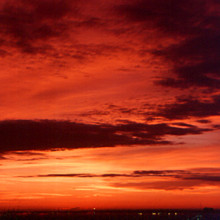
39:12 - Why does the Sun's activity vary?
Why does the Sun's activity vary?
with Lucie Green, University College London
The Met Office is working to compile the best possible observations of what the Sun is 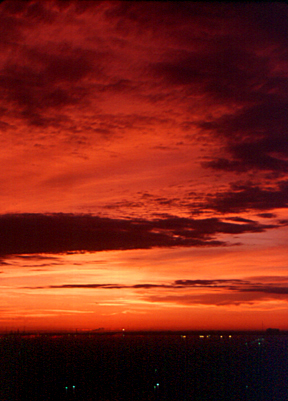 doing, in order to make predictions of when the Earth may face a particularly strong battering from the solar wind.
doing, in order to make predictions of when the Earth may face a particularly strong battering from the solar wind.
But elsewhere, scientists are working to understand why the Sun's activity varies, in order to form even better long-term predictions of how the Sun is going to behave in years to come.
One of those researchers is Lucie Green from University College London, who spoke to Dominic Ford.
Dominic - Now, Lucie, on the surface, the sun seems a very simple object. It's a ball of gas. It doesn't have solids and liquids on its surface. Why is it so difficult to understand?
Lucie - Well, it is a very complex object and I think that's something that's really become apparent to us over the recent decades. So, in particular with the advent of the space era which enabled us to put telescopes into space above the Earth's atmosphere and really showed the sun in all its glory. So, prior to the space age, we were viewing the sun just using, well mostly, using visible light. So, the wavelength that our eyes detect and if you filter or project an image of the sun, you see sun spots. But when we went into space and we started to see the short wavelength, the high energy radiation coming from the sun which we detected for the first time, the sun revealed itself to be this very complex object which is seething with hot gases or hot plasma - an electrically charged gas, but also magnetic fields. I think that really showed a level of complexity that we've been having to try and understand ever since.
Dominic - You've hinted there about the unique challenges of observing the sun. Astronomers spend a lot of their time looking at incredibly faint things in the night sky at incredible distances. The sun isn't like other objects that astronomers study, is it?
Lucie - No, we are not short of photons. We are not short of light to study. That's absolutely correct, but in a sense, we're lucky with the amount of light we receive from the sun and we're lucky that we can spatially resolve our local star. We can see the details on its surface and in its atmosphere. But that again, it adds into this level of complexity that makes the sun such a challenging object to understand. We see it varying second by second and we see it varying on very, very small size scales. Each time we build a bigger telescope that can see more detail on the sun, we have more questions to answer and that makes it very challenging.
Dominic - You mentioned there, sunspots. How are those connected to these explosions of plasma that might get sent out towards the Earth and cause problems for satellites?
Lucie - Sunspots are really fascinating features. So, first of all, we saw them as these dark spots on the surface of the sun and for, well, several hundred years they were drawn, they were counted, and they were followed on the sun. But then in 1908, an American astronomer, George Ellery Hale, built an instrument that detected the true nature of sunspots and he realised that they are strong sources of magnetic field, very, very concentrated strong magnetic fields on the surface of the sun. But these magnetic fields emanate up into the atmosphere and really, that discovery was the birth of solar physics because then we became able to understand how the sun is energised really because these magnetic fields, and this has got sort of an alien concept I think really, these magnetic fields that emanate out from the sunspots are able to store energy. When that energy gets released, it gets transformed from magnetic energy into light or particle accelerations and heating of the gases. When that happens, you get the forms of solar activity that we've mentioned already. So, solar flares happen when magnetic energy gets transformed into visible light, ultraviolet light, x-rays, and so on. Coronal mass ejections happen when this magnetic energy gets transformed into the kinetic energy of the motion of plasma out into the solar system.
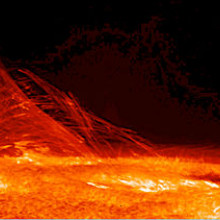
43:17 - Can the Sun affect Earth weather?
Can the Sun affect Earth weather?
with Joanna Haigh, Imperial College London
Earlier we heard about the effects that storms on the Sun's surface can have on 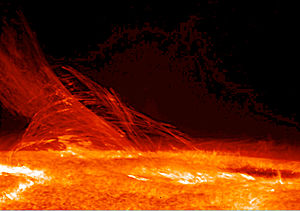 spacecraft and power distribution grids. But does variability in the Sun also affect the weather?
spacecraft and power distribution grids. But does variability in the Sun also affect the weather?
Dominic Ford spoke to Joanna Haigh from Imperial College, London.
Dominic - Joanna, we've been hearing a lot about the sun's activity in the form of spewing out plasma in the solar system. When we're talking about the sun affecting climate, is that the activity that we're talking about?
Joanna - No, it's not. So, those solar storms affect a very, very high atmosphere of the Earth. But when we're talking about climates, we're more interested in the sun's electromagnetic radiation. So, just the visible and perhaps a bit of the UV light, near infrared light that gets into near the Earth's surface and is warming the planet.
Dominic - So, it's changes in the amount of light the sun is putting out?
Joanna - That's right. So, we've heard about the 11-year cycle on the programme already and the amount of energy that comes out of the sun varies by about 1/10th of 1% over the 11-year cycle. So, that influences the amount of energy received into the climate system.
Dominic - So, with growing evidence for climate change in recent decades, do you think change in the sun's behaviour could be contributing to that?
Joanna - It's probably contributing a little bit, but we know enough about the energy coming out of the sun and about the factors that are causing climate change to be able to say that the sun can't be causing recent global warming. It might contribute a small fraction, but it can't be responsible for the whole thing.
Dominic - So, in terms of your work looking at connections between solar activity that the light the sun is putting out and the Earth's climate, does that mean you're having to look back in history to a time when we didn't have the industrial revolution and carbon dioxide levels rising in the atmosphere?
Joanna - Of course, that's very interesting. So, if we look back over very long periods, so sort of hundreds of thousands of years, you can see there's a cycle on ice ages and interglacials that are almost certainly related to the amount of radiation received from the sun. Now however, that's not due to solar activity. That's just due to changes in the Earth's orbit around the sun. So, we can see changes in climate due to changes in solar radiation. If we go to more recent history and then you look at the number of sunspots on the sun and you can see changes over hundreds years as Lucie has described, there are small changes in the global average temperature that perhaps are responding to those changes in the solar energy coming out.
Dominic - I suppose you must have a problem that the telescope was invented only 400 years ago. So, the best observations of the sun are only relatively recent. How do you know what the sun was doing more than 400 years ago?
Joanna - Indeed. So, you have to rely on what are referred to as proxy measures. So, measures of things that sort of you can interpret as being unrelated to solar activity. The most useful one is in cosmogenic isotopes. So, if we look in tree rings or ice cores, you can see that there's changes in the amount of ratios of beryllium atoms or carbon atoms. The ratios of those isotopes is depending on the amount of cosmic rays that are coming in from outer space. Now the amount of cosmic rays are modulated by solar activity. So, when the sun is more active, there's less cosmic rays and there's less of these cosmogenic isotopes. Those records go back very, very long time, hundreds of thousands of years.
Dominic - Now something that surprised me, reading up on this, was that people seem to be talking not just about the sun's light affecting global climate, but also on region weather systems. I would've thought the Earth was so far from the sun that it wouldn't affect one region differently from another.
Joanna - Exactly, that's very interesting. So, I think what we think is happening is that we've talked about the spectrum of radiation coming out of the sun and some of that radiation is in the ultraviolet. The ultraviolet radiation varies by more than the 1/10th of 1% I've already mentioned over the solar cycle. That radiation gets absorbed in the stratosphere where the ozone is. We can see signals of the solar cycle in the stratosphere and temperatures and ozone. Recent studies are suggesting that when that is going on that somehow couples with the lower atmosphere and you can get changes in circulation which then impact for example the temperatures in the North Atlantic. So, you can get quite much larger changes in Western Europe in response to the solar cycle than you do if you just look at the global average temperature.
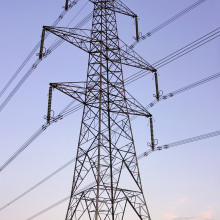
Can we protect the grid from solar storms?
We put this question to Lucie Green, from University College London (UCL)...
Lucie - Well, we can't stop its impact with the Earth. That's absolutely certain. So, when it arrives, what happens is it encounters the Earth's magnetic field.
So, these coronal mass ejections are magnetic bubbles themselves in a sense and then they interact with the Earth's magnetic field. If you change the Earth's magnetic field, you can start to create electric currents. But the national grids, they are interested in the very large events. There's day to day space weather as I said was sitting in a dynamic and variable atmosphere of the sun. But national grid in this country are really interested in the big one that could cause a lot of currents, set up a load of currents that would then affect their electricity networks. So, they do take into account what the sun does. They are watching it all the time. What they can do is make sure that there are people at the relevant substations that need to be monitored. But they do have ways of bringing up power lines if necessary and monitoring the systems. But all of these take time, and this is why we need the forecast, the warning of what's going to arrive at us and whether it's going to have a strong impact.
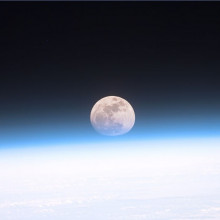
Are solar stoms visible in the air?
We put this question to Joanna Haigh from Imperial College London...
Joannna - Well, if you're talking about solar storms and space weather, that has very little effect on the climate and the weather down below. It's much more impact on the power and communication satellites and that sort of thing.

50:36 - Does the expansion of space slow the speed of light?
Does the expansion of space slow the speed of light?
Hannah - So, does the speed of light change? Dr. Andrew Pontzen from University College London provides the answer.
Andrew - So far as anyone can tell, the speed of light in our universe is absolutely fixed. It does not change.
Hannah - The speed of light travelling in the near vacuum of space clocks in at just shy of 300 million meters per second or 186,000 miles per second. So, if space is expanding, doesn't that mean that objects in space are also expanding including atoms in our meter ruler that we use to measure distance by? Well, space expansion isn't actually uniform. Our Milky Way and the galaxy next to us, Andromeda are moving closer to each other but in general, galaxies are getting further apart as space expands. In this case, does this non-uniform expansion affect the meter rule somehow and therefore, affects speed of light? Well, back to cosmologist Andrew Pontzen.
Andrew - As you can imagine, the fact that the universe is expanding and distances change over time, does make this a bit more complicated. You might think it even makes what we call speed of light ambiguous because distances mean something different at different times. But actually, it doesn't. You can still define what we mean by the speed of light pretty well because it has an effect for instance on the structure of atoms themselves. This is through something called the fine structure constant which is just a number that the speed of light appears in. So, if the speed of light were different, the structure of the atoms would also be different. Because of that, by looking through telescopes, we can actually tell that the structure of atoms hasn't changed over time and that's what makes us pretty confident that the speed of light must be fixed.
Hannah - Okidok, rest assured, our speed of light is not decreasing and time is not speeding up either, or is it?
Andrew - There is a possible complication which is something called string theory which is a possible theory of everything, sort of a better version of physics. It does allow for this fine structure constant to change. So, it is possible that in our universe, the fine structure constant and so the speed of light is effectively changing over very long timescales. But whenever anybody has looked for any evidence of that, they have found no evidence. So, as far as we can tell, the speed of light is fixed.










Comments
Add a comment